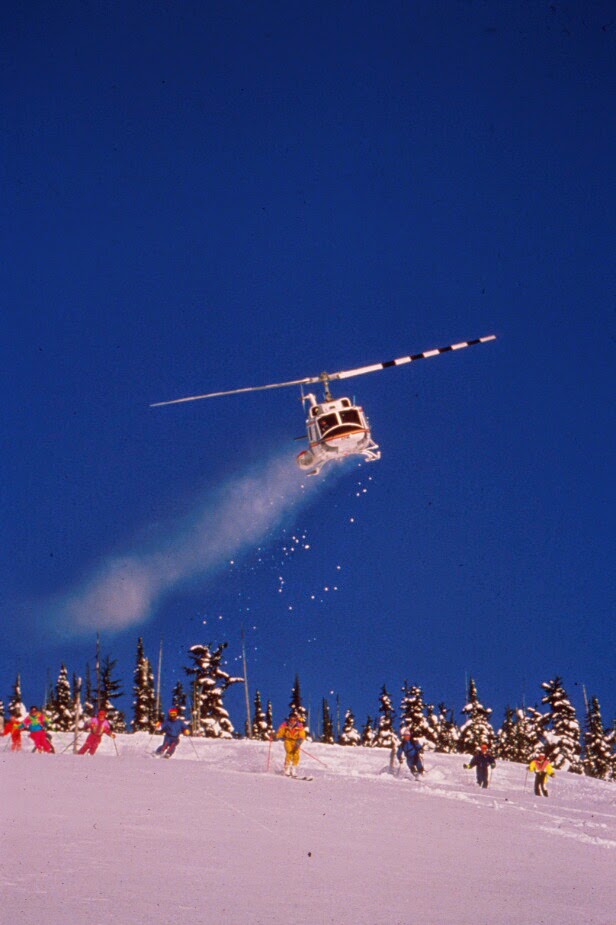Working for a
heli-skiing operation would be a dream-come-true for many an avid backcountry
skier. But faced with the challenging job of directing a heli-ski company’s
sustainability program, it may not be as cushy as it sounds. Dave Butler (RPF,
RPBio) has the tough job of Director of Sustainability for Canadian Mountain Holidays (CMH) Heli-Skiing &
Summer Adventures. He started his career as a Park Warden in Banff National
Park, Canada, went on to work in government handling adventure tourism tenures,
and moved to CMH in 1997.
 |
| Bell 212, photo by Brad White |
The
Banff-based company operates in 11 mountain areas of South Eastern British Columbia,
bringing in annual revenues of around CDN$60 million with a 70 percent
repeat-booking record. CMH holds license rights
from the B.C. government to more than 14,000km2 of remote territory in the
Purcell, Cariboo, Selkirk and Monashee mountain ranges and is several times the
size of its closest competitor in heli-ski visits. Its operations include up to
30 helicopters and eight remote lodges—many accessible in winter only by
helicopter. There are three main strands to its business: heli-skiing,
heli-hiking, and mountaineering.
 |
| Dave Butler |
As part of the senior leadership team, Butler heads up CMH’s sustainability program including governance, implementation and reporting. “The company’s efforts have been recognized with a range of provincial, national and international awards,” Butler says. “I coordinate cross-functional teams and the integration of fiscal, environmental and human components of the business and I ensure the company’s approaches are consistent with its long-term sustainability.” Focusing on government and community relations, Butler deals with all land/resource tenures and regulatory issues. “And I supervise, and am accountable for, work of the Run Development Coordinator and Manager of Remote Fuel Operations - both seasonal positions,” he adds.
 |
| CMH tree skiing - photo by Mike Welch |
Over the years, CMH has trained its guides
to keep a vigilant watch for wildlife. The guides plan their flying and skiing
routes to avoid contact, and all wildlife sightings are provided annually to
the B.C. Government for their overall management purposes. They use computer
software to map wildlife sightings, and to maintain a sense, over time, about
the areas where animals spend their time at various times of the year. CMH also looks to external
biologists to give them a sense of how best to behave in these habitats.
One
of the company goals is to increase energy efficiency in all aspects of the
business. This helps alleviate costs as well as reduce CMH’s overall footprint. “So, rather than paying money for off-sets,
we use every dollar available to continue to look for ways to be more efficient
in our energy use,” Butler explains. “Examples include the way we light and
heat the lodges, the ways in which we use helicopters, and the way we move our
guests to/from our lodges.”
 |
| Yours truly (second from left, top) with Chicks in the Chopper Gang |
Environmentalists
typically raise concerns about the negative environmental impacts of
heli-tourism on fish and wildlife, about waste and fuel storage areas, and
about noise pollution. Vegetation, too, can be a contentious environmental
issue. In the summer, existing hardy trails are used where possible, and use is
dispersed throughout each operating area so that impacts on fragile alpine
environments are minimized. CMH claims that the
potential impact on the land in the winter is negligible because visitors leave
only tracks in the snow. CMH guides are trained in
the latest low-impact travel techniques for alpine areas, and they share these
approaches with the visitors. CMH also works with local
forestry companies coordinating efforts to harvest in ways that work best for
skiers while reducing the visual impact of harvesting. Landing and pick-up
locations are also placed in areas of minimum impact on the forest.
Waste
reduction is also important to CMH. For example in the
Adamant Lodge in the Selkirk Mountains, food waste (that used to be consumed by
lodge pigs before hoof-and-mouth scares) is eliminated by using a prototype
composting system developed by maintenance manager, Duane Dukart. In 2002, CMH
established the ‘President’s Award for Environmental Initiative’, a programme
which empowers all staff to take a look at what they can change in their own
jobs that will help the environment. Dukart received the first President’s
Award for his efforts to promote environ- mental stewardship. The same system
is now used in the Bugaboo lodge. The company also employs the latest
technology in sewage treatment and uses only environmentally-friendly soaps and
paper.
Helicopter
fuelling locations use leading edge technology to prevent fuel spills from
reaching the ground or the water. These systems include engineered containment
berms and a state-of-the-art emergency spill response system. Use of helicopters
is minimized wherever possible, as this is the greatest direct cost of
operations. The fuel for the helicopters is stored at the lodges, and at remote
fuel caches, using leading-edge storage facilities.
In order to communicate its strong sustainability
standpoint CMH produces regular
reports which are posted on its website.
Sustainability and environmental policies are also used in marketing messages
to potential and return guests. And staff members who interact with guests or
media are trained in presenting CMH’s environmental
approaches, giving solid examples. “This includes media interviews, and special
talks and presentations at colleges and universities, to special interest
groups, and at tourism conferences,” Butler adds.
In
2014 CMH created a new internal Sustainability Advisory Group:
“a ‘think tank’ responsible for ensuring we keep looking for both low-hanging
fruit, and larger company-changing ideas. This has only been in place since
November. A very different approach than our old Second Nature team,” says
Butler.
 |
| Group Skiing with CMH - photo by Brad White |




